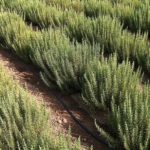Author – Robin Siktberg
For farmers growing rosemary, weed control is a challenge. Rosemary is not a particularly fast-growing crop, and it can be easily overtaken in its early stages by more vigorous weeds. Currently, there is only one herbicide – glyphosate – registered for rosemary. While glyphosate is usually effective, it is a contact herbicide, and rosemary is not tolerant. Therefore, glyphosate cannot be broadcast; it must be sprayed using ground rigs with directed nozzles. The latter method has some complications of its own, because rosemary has a shrubby growth habit and often branches low to the ground. In addition, the ground-application vehicles can damage the plants. Rosemary roots are quite sensitive to compaction and breakage, and if damaged, parts of the plant will die back.

One of the most important best practices for avoiding potential weed resistance is to use a variety of weed control products with multiple modes of action. With glyphosate presently the only approved weed control product for rosemary production, the addition of a new solution with a different mode of action would be good news for growers.
IR-4 Tests Trifluran on Rosemary
In 2012, IR-4 initiated a study to determine the efficacy and safety of trifluran, a selective, long-residual herbicide marketed as Treflan® HFP (trifluran), in rosemary production. Rosemary is grown commercially for cosmetic and food use, so determining maximum residue levels of any inputs used is required by EPA. About 500 acres of rosemary are grown commercially in the United States. Trifluran can be incorporated at planting time to inhibit germination of weed seed, and it can also be applied via irrigation systems after the crop has been established, an extra bonus since rosemary is grown as a perennial crop.
The study included fields in four locations: Arkansas, North Carolina, California, and New Mexico. In all locations, trifluran was applied as a pre-plant application by broadcast spray and incorporated at a depth of 1-2 inches mechanically or through sprinkler application at up to 1.0 pound of active ingredient per acre, depending on soil type (less for course soil, more for fine soil). Young plants were planted within seven days of this application.
A second application of trifluran was made on these same fields through sprinkler/furrow irrigation, also at the rate of up to 1.0 pound of active ingredient per acre.
Both dried and fresh samples from all the plots were collected 60 days prior to harvest and submitted to the Food and Environmental Toxicology Laboratory at the University of Florida, Gainesville, and tested for residue levels.
Trials Result in EPA Approval
The research found that trifluran exhibited good weed control and increased yield compared to the hand-weeded control. There was good crop tolerance, as well. Trifluran is listed for a wide variety of broadleaf and grassy-leaved weeds, but in the trial, the problem weeds in the field that were well controlled included Kochia, Panicum spp., and Amaranthus spp.
As a result of the findings of this research, trifluran was approved for a supplemental label for use on rosemary in February 2019, giving growers an easier option for weed control and another mode of action to decrease the likelihood of herbicide resistance in their fields. It must be applied no later than 60 days before harvest, and it is limited to two applications per year at labeled rates.
Robin Siktberg is a technical writer for Meister Media; .
